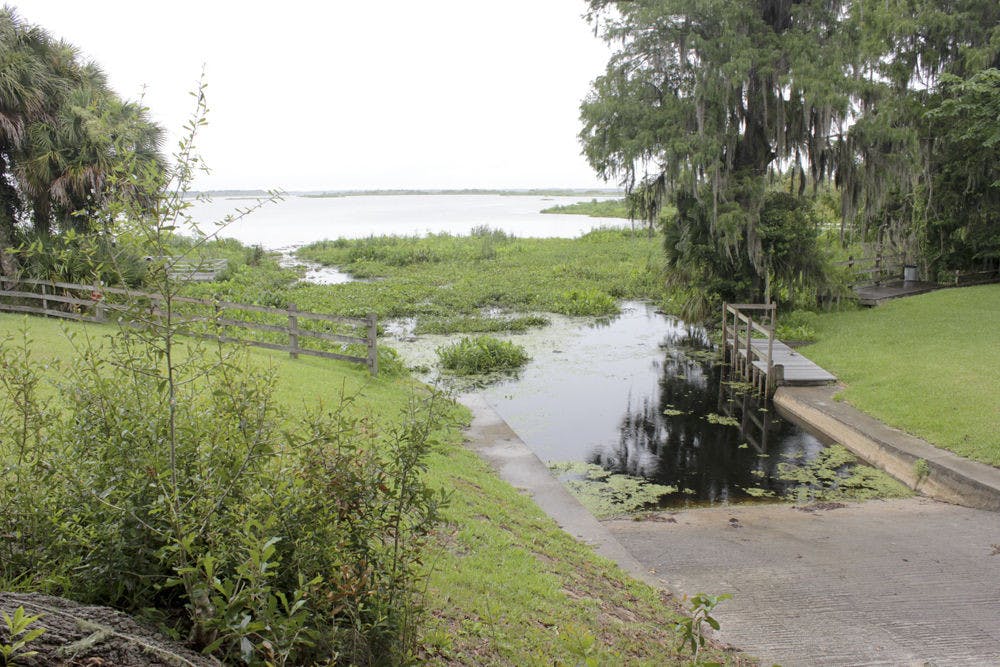North Central Florida’s biggest lake is vanishing down a sinkhole.
Stretched like a brown patch between Marion and Alachua county, Orange Lake, near Ocala, is famous for its bass fishing and wetlands environment. But now, nature and human influence have created a disquieting trend in Orange Lake, whose shores have spent decades draining down a sinkhole into a depleted Floridan aquifer during droughts.
“My bait and tackle shop has been closed,” said Robert Shidner, owner of South Shore Fish Camp on the lake.
Shidner, who’s owned his camp for the past 15 years, believes Orange Lake’s decreasing water levels are due to sinkholes located along the lake bottom. The sinkholes are directly connected to the Floridan aquifer, which is being continuously drained for human use.
While Orange Lake’s shores have historically shrunk during droughts and refilled when rain is plentiful, the past quarter century have demonstrated extreme water-level drops well below historical trends.
Orange Lake is 12,550 acres in size and an average 5.5 feet deep, but the water level fluctuates an average of two feet annually.
Data from the St. John’s Water Management District, the agency which oversees lake, river and stream management throughout northeast and east central Florida, demonstrates lake levels following rainfall patterns.
However, in the past quarter century, the lake’s water levels have dipped into extreme lows despite rainfall congruent with historic patterns.
According to the U.S. Geological Survey, when the aquifer’s supply is plentiful and rainfall steady, Orange Lake expands into its normal size, but when the aquifer drops below normal, water from Orange Lake drains into the aquifer to compensate, which lowers lake levels below their natural depth.
The U.S.Geological Survey reported Floridians used about 134 gallons of water per day in 2010. Much of this is drawn from Florida’s aquifers, exasperating water-level problems on the lake.
Dan Canfield, a professor of limnology in UF’s Department of Fisheries and Aquatic Sciences, said he believes Orange Lake will eventually become another Paynes Prairie unless more is done to maintain its water levels.
Officials have tried to isolate and plug Orange Lake’s sinkholes with debris since 1964, but the problem has worsened due to the overall depletion of the aquifer.
In 2003, Marion County officials proposed a way to plug the sinkhole in the lake, but authorities rejected the plan, saying it would interfere with the lake’s natural rhythms.
“Wide fluctuations in water levels are important for long-term maintenance of healthy lake and wetland habitats for fish and wildlife,” said Teresa Monson, a public communications coordinator for the St. Johns River Water Management District.
The lake recently recovered from a six-year drought, during which water levels dropped to the second lowest on record.
Depressed water levels have allowed plant life to grow in dried-up areas of the lake usually covered by water. The foliage floats to the top of the lake and becomes floating islands of mud and vegetation, called tussocks, covering hundreds of acres on the lake’s surface.
These drifting rafts of vegetation, known as tussocks, are obstacles for local fish camps and boating companies.
Tussocks prevent boats from traversing Orange Lake due to a fear of clogging engine motors.
“Some of them can be up to anywhere from three to 10 feet thick of muck,” Shidner said. “There is roughly 9,500 acres of floating tussocks and islands on Orange Lake due to the years of drought we’ve had.”
The tussocks have compelled local legislators to begin making preliminary plans to clean the surface of the lake by creating a lake management group known as the Orange Creek Basin Interagency Working Group.
While their focus has been primarily on discussing ways to clean the lake’s surface, the plan may only be a short-term solution to the lake’s long-term problems.
[A version of this story ran on page 3 on 6/29/15]
Rain falls on Orange Lake at the Heagy Burry Park boat ramp Monday. Sinkholes along the bottom of Orange Lake are lowering water levels, preventing boats from safely launching on to the lake.






